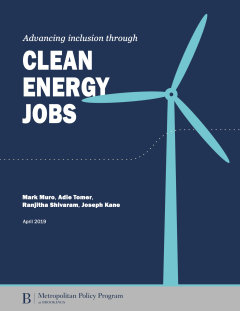
The transition to a clean energy economy continues. Motivated by mounting scientific evidence, shifting market forces, and in some cases policy, U.S. industries have responded by installing more zero-carbon energy sources, developing more energy-efficient products, and adopting more environmentally-sensitive standards. More recently, debates have broken out in Congress over the need for an ambitious Green New Deal centered on clean energy economy employment. As a result, shifts in “green jobs,” carbon emissions, electricity consumption, and resilience to climate shocks have become some of the highest-profile, most-debated trends of the decade.
While much has been written about all of those topics, considerably less attention has been paid to how all this intersects with the workforce. Over the years, assessments of the “clean” or “green” economy have often focused on “sizing” the sector by counting associated jobs under various clean energy activities. These counts are vital, confirming the extent of the country’s energy evolution. Yet they tell us little about the nature of work and the occupations necessary to deliver a functional clean energy economy moving forward.
Focused squarely on the workforce side of the clean energy transition, this analysis intends to help energy-sector professionals, state and local policymakers, regional education and training sector leaders, and community organisations get a clearer look at the nature, needs, and opportunities associated with the future clean energy workforce. In particular, this analysis aims to explore the extent to which such occupations will offer inclusive pathways to economic opportunity.
